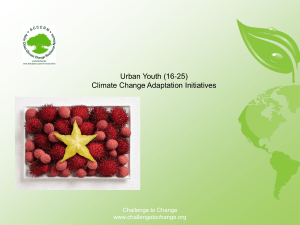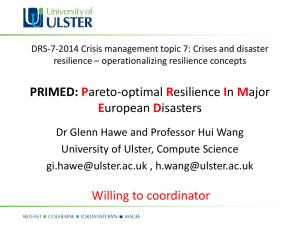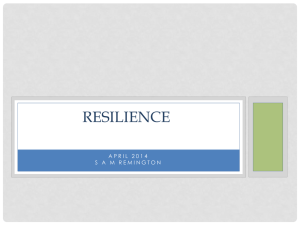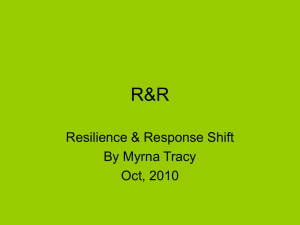Tool - IUCN
advertisement
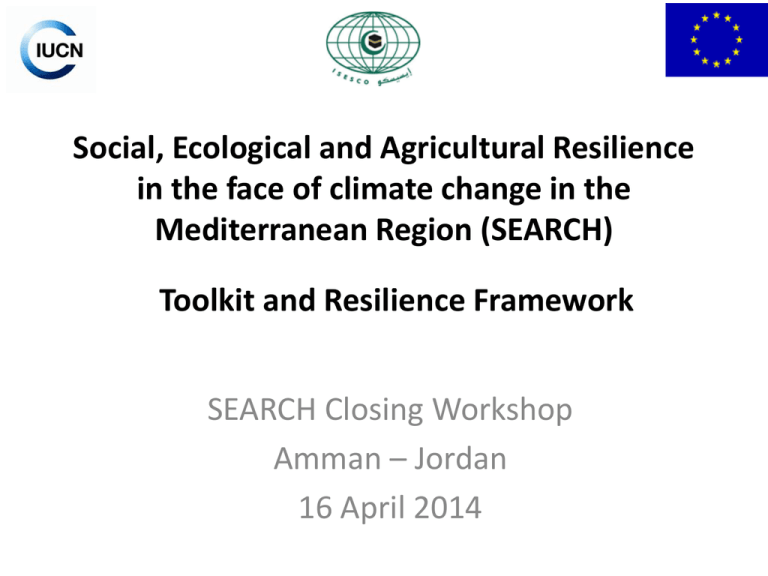
Social, Ecological and Agricultural Resilience in the face of climate change in the Mediterranean Region (SEARCH) Toolkit and Resilience Framework SEARCH Closing Workshop Amman – Jordan 16 April 2014 I. Toolkit • Aim of the Toolkit – The aim of the toolkit is to provide guidance and recommendations on how to develop climate change resilient strategies and plans at national, sub-national and local levels. Use of the Toolkit • Conduct stakeholder analysis and gather data on views and perceptions of local communities, • Identify causes and effects of climate change impacts, • Assess vulnerabilities and resilience of social and ecological systems, • Prioritize adaption options and develop climate resilient plans, • Provide a solid knowledge base for decision making, • Link theory with practice, research with application. The Added Value of the Toolkit • It provides practical tools for guiding various practitioners, planners and decision makers in integrating climate change risks not only in national strategies but also in the strategies and plans at local level and also at watershed level. • It clearly demonstrates the flows of activities under each practical step and shows how these different steps are interlinked to deliver integrated and more resilient climate change adaptation plans. Toolkit Setup Toolkit Structure S1-Tools to Understand the System • Resource and Capacity Assessment Tool - RIDA Stakeholder Analysis Tools - PRA & RAAKS • • Defining Actors Linkage and Relation Analysis Problem Identification and Analysis Tools: Problem Tree S2 - Vulnerability Assessment Tools Community-based Risk Screening – Adaptation and Livelihoods (CRiSTAL) Tool Vulnerability Assessment of the watershed Affected area/ sector Downstream area Water sources Plantation area and infrastructure Event(hazards) Flood Drought Frost wave Wind storm Degree of Sensitivity of the System Degree of the adaptive capacity High-As a closed watershed, runoff water from hilly areas drains to and accumulates in the downstream area. High-The downstream area is very sensitive to flood. Low-Suggested adaptation measures can only upgrade the system partially, and these options are costly. High-Groundwater that forms the main water source is directly affected by the amount of precipitation. High-Summer water needs already greater than production, and groundwater abstraction faced by many regulatory problems. Exposure Medium-There is an ability to regulate groundwater exploitation. Some upgrade measures adopted by now but are not enough. Medium-The area suffers Medium-Impacts magnitude repeatedly from frost and affected areas change wave in winter months from year to year. causing severe impacts on the area. Low- Some upgrades already adopted, but need modifications. Negative impacts mostly limited to some crops. Medium-Unpredicted windstorms mostly cause damage of crops, and infrastructure. Medium-Some modifications can be implemented to reduce the impacts. Medium-There is an ability to upgrade the system by improving the system itself, but it is considered costly for some people. Vulnerability of the area High High Medium Medium Ecological Vulnerability Assessment Tool Sustainable Livelihoods Approach (SLA) High temperature and low precipitation Livelihood Assets Andaket Aydamoun/ Karmchbaat Qoubyat Education Level High Medium High Poverty Level Low High Low Income Medium Low Medium Access to Health Services Medium Medium High Awareness Level Medium Low Medium Dependency on Agriculture Low High Low Dependency on Water Resources High High High Dependency on Livestock Low High Low Dependency on the Forest High High Medium Ownership of House Yes Yes Yes Ownership of Land Yes Yes Yes Presence on Vehicles Yes Yes Yes Presence of House Electronics Yes Yes Yes Participation in the House High High High Membership in Local Societies High Medium High Dependency on Retirement High Medium High Dependency on Employment Salary High Medium High Trade High High High Human Capital Natural Capital Physical Capital Social Capital Financial Capital Vulnerability Mapping Tool • areas marked with red colour shows the lowest HDI ranked areas. S3 - Adaptation Strategy Development Tools Analysis and Refinement of Vision and Scenarios Scenario Building Finalisation of Detailed Strategy Activities Scenarios S1 Mobilizing community resources to adapt to climate change Involving private sector in the activities to adapt to climate change. Establishing partnerships with donors in order to fund projects that strengthen farmers to adapt to climate change. S2 √ √ √ √ √ √ Projects to manage solid and liquid wastes in all villages of the district. Producing bio fertilizers using agricultural wastes. Follow the Crop rotation (which organizes the process of cultivating) Provision of crop varieties adapt to the effects of climate change (high temperature and water shortage). Preventing encroachment on agricultural land. Laser leveling Developing new varieties of crops, high production and provision of these crops in the agricultural cooperative associations. Soil improving. Windbreaks in the areas near desert Apply balanced fertilizing programs to face climate change impacts Distribution of accredited seeds and crops Recycling of agricultural wastes Cultivating Moringa tree rather than decorative plants in order to benefit from the economic, nutrition and health value and rationalize water consumption. Raising awareness and train farmers on adapt to climate change, through farm management, appropriate cultivation time, agricultural processes including plowing, irrigating, fertilizing and combat pests and diseases. NGOs do follow-up and monitoring of climate change and the exchange of data with the stakeholders in order to be analyzed and develop solutions. S3 √ √ √ √ √ √ √ √ √ √ √ √ √ √ √ √ √ √ √ √ √ √ √ √ √ √ √ √ √ √ √ √ √ √ √ √ √ √ √ √ √ √ √ S4 - Planning Tools Sustainable Technical interventions Connect houses to the sewage network to prevent pollution of the ground water Monitoring system for the wells that are used by factories, farms, and quarries Implementation tools Waste water management project Monitoring Program for industrial and agricultural water Relevant Stakeholder Ministry of Water and Irrigation, Water Authority Grey water reuse (mainly kitchen) Supported and funded project Rehabilitation of the Local springs Springs development project Improve Soil properties and compost fertilizers Prepare local projects Use of modern irrigation system Through projects Rain water harvesting Cisterns drilling or building cement reservoir to harvest rainwater Introducing animal production system (fish , bees, goat) Use of green houses Community Revolving funds Community Revolving funds Ministry of Agriculture, Ministry of Water and Irrigation, Ministry of Interior Ministry of Agriculture, Universities, Public and private research centres, Local community societies, NGOs Ministry of Agriculture, Universities Public and private research centres, NGOs Water Authority, CBOs through revolving funds’ system, Ministry of Agriculture, Agricultural Credit Corporation(ACC) Universities Agricultural Credit Corporation, Ministry of planning, Donors ACC, Ministry of Agriculture, Donors Providing farmers with agricultural tools to decrease the financial cost (Agr.inputs ) Introducing food processing and an appropriate Community Revolving funds ACC, MOA, Donors Community Revolving funds CBOs, Donors Ministry of Water and Irrigation (MOWI), Water Authority, Ministry of Environment (MOEnv), Ministry of health (MOH) MOEnv, MOH, JOHUD, Royal Scientific Society (RSS) Prioritisation and Ranking Prioritization Matrix Project Ranking Weight Criteria Social Economical Environme ntal Technical Job creation Health impact Expected Revenue Rating Scale 1 1 Project 1 2 Projec t2 3 Projec t3 Rehabilitation of old water tanks and installation and/or maintenance of water networks for irrigation in the Aydamoun village Budget estimate (USD) Need of local Constraints communities Source of financing Priority Availability of funds from municipal contribution High 28,000 SEARCH 1 20,000 Fundraisi ng 2 35,000 Fundraisi ng 3 25,000 Fundraisi ng 4 Unstable security situation in the overall region Limited awareness and knowledge of the locals 2 Cost Pollution 3 Preserving 4 Technology 5 Promote alternative income generating activities to upgrade livelihoods in Aydamoun Medium Unstable security situation in the overall region Availability of funds to provide training, activities and utensils/tools Persistence of ingrained (ancestral) unsustainable overgrazing practices Develop a rotational grazing program for Aydamoun and Qobayat forests Medium Rivalries between shepherds Absence of infrastructure adequate Ingrained overgrazing habits Develop and implement a forest management plan for Aydamoun and Qobayat to control forest fire events grazing unsustainable Landownership concern Low Lack of technical forestry experts specialized in traditional sylviculture practices Unstable political situation and conflicts amongst stakeholders S5 - Implementation Tools Accountability and rights analysis Pre-Conditions for Success or Failure of Ok accountability at the community level Awareness/Capacities & Local community has knowledge capacity & skills to adapt to climate change Benefits Take into consideration the needs of various social groups Mid Slight Low People are aware of problem & have the ability to rank priorities Local community is aware Local community is aware of the available resources and have knowledge of with capacities to identify their natural situation problems Understanding the Address rights and different interest & interest of others in the rights of various social community groups “farmers, women, poor” Identify individual interest (benefits, revenue) regarding natural resources Access Rights and Control Group accountability to government authorities for respecting their rights toward natural resources Local community accountability towards respect for the right of different social groups “farmers, women poor” Rights and roles of different community groups are addressed Dominant groups have access according to rights Community Leadership Responsible leadership activities accepted by local community Organized groups can promote voluntary work & advocate rights Identify Potential Groups to promote a collective work “voluntary work” Address individual leaders among local community Group process Organized groups have Consider social diversity the ability and capacity to within organized groups claim benefits Identify various social group in forming organized groups Organized group include dominant sector only S6 - Reflection Tools • Multi-level, multi-stakeholder platform creation • Process documentation • Information and knowledge management including communications • M&E and Feedback II. SEARCH Resilience Framework Defining Resilience SEARCH “A watershed system’s capacity to absorb, manage, and adapt to social and health, agricultural, and ecological changes (or stressors) while still maintaining its essential structure, feedbacks, and functionality.” • IPCC 2008 "The ability of social and ecological system to absorb disturbances while maintaining the same basic structure and functioning. The capacity for self – organization and the capacity to adapt to stress and change". Population Growth Urbanization Infrastructure Natural Resources / Ecological Systems Resource Users / Social System Climate Change Increased Demand Policy and Governance Pollution Resilience Framework Linking Toolkit with Resilience Framework Diversity Organization and Adaptive Governance Technology and Infrastructure • Tools for understanding the system, its diversity, its capacity and its main actors and problems facing it. • Tools to define adaptive capacity, governance and organization • Tools to define system's social, economic and ecological vulnerability • Tools to formulate plans, defining actors roles and responsibilities and define feasibility of various plans. • Tools to rank and implement the most feasible plans • Tools for monitoring evaluation, documentation and feed back Learning Resilience Assessment • methodology is based on qualitative multiattribute modelling supported by the DEXi software. • final goal for the designed tool is to help monitoring and assessment of resilience by identifying and characterizing positive change (the shift) when this occurs. • The proposed framework also seems to allow for both consistency and flexibility Model Structure • Define Criteria to measure resilience – – 14 attributes representing the weakness of the system (used to assess vulnerability in the project sites and for different sectors) – 16 attributes related to adaptive capacity and the strength of the system properties were selected. • These 30 attributes constitutes the actual inputs of the model. • These terminal attributes are aggregated to form the different elements of the resilience components, with the exception of two elements, namely Innovation and Capacity (Infrastructure and Technology), which have no selected attributes but were integrated as terminal nodes at their hierarchical level. • All attributes used are qualitative and can take discrete and symbolic values represented by words. In our model, we used a maximum fivegrade value scale ("very high", "high", "medium", "low", "very low") • Decision attributes is aggregated from basic attributes (terminal nodes) towards the output (root node) DEXi resilience1.dxi 3/27/2014 Page 2 DEXi Scales Attribute resilience diversity economic services gdp income health services percentage local budget government contribution livelihoods stability of income poverty level sources of income migration rates natural services water resources deforestation/desertification land ownership & quality natural cover species integrated land use planning capital-innovation built capital domestic water supply wastewater facilities energy services techn. exp. available natural capital natural infrastructure use of local knowledge innovation self-organisation local level n & type of CBOs facilitation & leadership intermediate level equity legitimacy national level cross-scale institutions accountability coordination GOs learning awareness support of community education learning per se learning from crises capacity Scale very high; high; medium; low; very low very high; high; medium; low; very low very high; high; medium; low; very low increase; constant; decrease suffisant; insuffisant; zero developped; available; not available high; medium; low high; medium; low very high; high; medium; low; very low stable; fragile; instable high; medium; low diversified; medium; limited immigration; zero; emigration very high; high; medium; low; very low abundant; available; scarcity high; medium; zero equitable-productive; equi-marginal; not equi-productive; not equi-marginal high; medium; low high richness; medium; poor present; absent high; medium; low high; medium; low generalized; partial; absent available; not available electricity; petrol; wood high; medium; low high; medium; low high connectivity; medium connecctivity; low connectivity high; medium; low high; medium; low high; medium; low; very low high; medium; low active; present; absent active; present; absent high; medium; low high; medium; low high; medium; low high; medium; low active; present; absent high; medium; low high; medium; low very high; high; medium; low; very low high; medium; low high; medium; low high; medium; low high; medium; low high; medium; low resilience1.dxi 3/27/2014 Evaluation results Attribute resilience diversity economic services gdp income health services percentage local budget government contribution livelihoods stability of income poverty level sources of income migration rates natural services water resources deforestation/desertification land ownership & quality natural cover species integrated land use planning capital-innovation built capital domestic water supply wastewater facilities energy services techn. exp. available natural capital natural infrastructure use of local knowledge innovation self-organisation local level n & type of CBOs facilitation & leadership intermediate level equity legitimacy national level cross-scale institutions accountability coordination GOs learning awareness support of community education learning per se learning from crises capacity Resilience before project very low very low very low constant insuffisant not available low low low fragile medium limited zero high available medium not equi-productive medium high richness absent low low absent not available electricity low medium medium connecctivity medium medium low low present absent low low medium medium present medium medium low medium medium low low low Resilience after project low medium very low constant insuffisant not available low medium medium fragile medium medium zero high available medium not equi-productive medium high richness present medium medium partial not available electricity medium medium medium connecctivity medium medium medium high active present medium medium medium medium present medium medium low medium medium low low medium Model Results • • • • • • • • • increase of government contribution (through funds of Morocco Green Plan) increase of sources of income (improvement of tree fruits and aromatic herbs plantation) promotion of integrated land use planning (elaboration of a tool kit to integrate climate change and land use planning in municipal development plans) partial improvement of domestic water supply (domestic rainwater harvesting) increase of technical experience available (through trainings on aromatic herbs planting and through constructing rainwater harvesting systems) shift of number and type of CBOs from present to active (increase of number of CBOs by creation of one association of farmers and two groups of women, empowerment of one agricultural cooperative of women). introduction of a process of facilitation and leadership that was absent (through a technical team grouping key stakeholders working with communities, CBOs, municipalities and others) enhancement of cooperation between local organizations (equity) empowerment of capacity (training of farmers, introduction of new agricultural practices, publication of several documents as learning tools, exchange of information, facilitation of group processes) Outcome • Components of Resilience that have changed were – Diversity (from very low to medium) mainly because of a slight increase of sources of income of livelihoods, – Capital and Innovation (from low to medium) due to the introduction of a rainwater harvesting technique and improvement of technical experience available, – Self-organisation (from low to medium) at local and intermediate levels. resilience1.dxi 3/27/2014 – DEXi Overall resilience shift has been from "very low" to "low". Page 24 Chart Resilience before project Resilience after project capital-innovation capital-innovation medium low medium self-organisation diversity medium self-organisation diversity low low learning learning Conclusions and Next Steps • Resilience is a relatively new issue for the climate change and water sector. Generally, there is a lack of awareness throughout the sector and the general public of the concept and its application. • To build climate resilience at the country or basin level, policy makers must figure out how to integrate success stories from local level project implementation into more strategic planning instruments at broader scales • Adaptation based solely on prioritisation of discrete actions – for example on infrastructure, institutions, or ecosystems – may lead to missed opportunities to build resilience towards a dynamically changing climate, where uncertainty and unknowns are expanding Conclusions • Building climate resilience is dependent on how well established the adaptive governance capacity is (the ability to apply adaptation measures in practice from community to national and basin scale). • Ensuring a good adaptive governance capacity requires that local knowledge, access to resources, leadership, mobilisation, and financing are available to strengthen the resilience. Conclusions • Realizing resilience requires the presence of dreamers, believers and practitioners who act sequentially but cumulatively to make the positive change. • Dreamers (or planners, visionaries)are those who can initiate the logic for change, and usually include high-level decision makers who serve as ambassadors for mainstreaming climate change within national strategies; • Believers or the champions of the resilience building process (the Facilitation Team)are those who take on the role of advocating and guiding intermediate- and local level stakeholders through a structured process of learning and participatory adaptation planning toward the integration of resilience considerations into adaptation planning at national, intermediate and local levels; • Practitioners at the local level are those who will transform theoretical knowledge into practical implementation plans on the ground through testing and piloting of various tools and methodologies and choose the most practical and successful ones that lead to developing more resilient plans. Conclusions • Using the various tools listed in this toolkit will only provide guidance for the users to enable them from indentifying the main climate risks and resilience and how they can develop recommendations to integrate such resilience within national plans and strategies. Recommendations • Integration of climate change resilience will not be materialized without involving all relevant stakeholders, including dreamers, believers and practitioners in planning process from its early stages. • Raising awareness about the conditions of vulnerability and the best interests of the community is critical. • Gaps in capacities needed among both believers and practitioners to be identified and addressed early on. Capacities need to be built amongst those various actors to design and implement resilience measures widely Recommendations • Empower politicians by providing relevant information to better understand the societal costs of not working on resilience • Create an environment where believers and practitioners are encouraged to experiment with small-scale innovations that make incremental improvements on present practice. • Ensuring widespread recognition of those championing innovation by the dreamers or planners at national level would also help the cause of adaptation. • Create both formal and informal opportunities for practitioners to communicate and share ideas about their latest innovative projects or initiatives would contribute to this as well. • Focus on initiatives that bring tangible results at the early stage of planning


